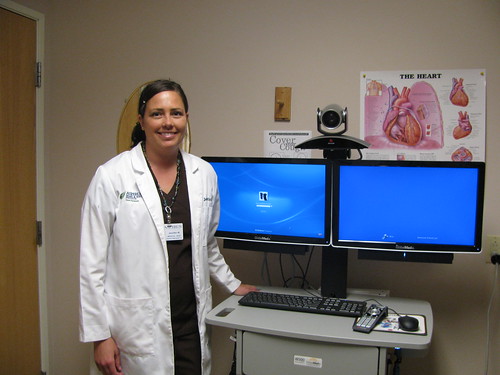USDA Blog Post:

Nurse Jennifer Witting stands beside newly installed telemedicine equipment at the Aspirus Keweenaw Hospital in Laurium, MI in June 2012. The Aspirus Health Foundation, Inc. received two Distance Learning and Telemedicine (DLT) grants through the U.S. Department of Agriculture’s (USDA) Rural Development (RD) DLT Program, that enabled Aspirus to grow their Telehealth infrastructure into communities in north-central Wisconsin and the western Upper Peninsula of Michigan. USDA photo.
This week at USDA we are celebrating National Health IT week by highlighting USDA’s ongoing efforts to expand modern health care access to rural America. Yesterday, we announced two new steps to improve health care for rural Americans – both through new investments in health infrastructure and ongoing interagency partnerships designed to better focus Federal efforts on rural health care.
USDA is expanding a partnership with HHS and the Department of Veterans Affairs, as part of our work together on the White House Rural Council, to leverage funds and other efforts that will support advanced health care technology in rural hospitals. This partnership is an extension of a successful pilot launched in five states – Illinois, Iowa, Kansas, Mississippi and Texas – to identify rural critical access hospitals in persistent poverty areas in need of advanced health care technology. For example, during the pilot phase of this partnership, the USDA Rural Development Iowa State Office, the Iowa Regional Health IT Extension Center (REC) and the Iowa State Office of Rural Health convened the first Iowa Rural Health IT Forum to expand care for Critical Access Hospitals.
Meanwhile, we are continuing to let folks know about HHS and VA health care initiatives. This has included the Department of Veterans Affairs Rural Veterans Coordination Pilot Program, to empower rural organizations in promoting high-quality health care and mental health services for our veterans. And last week, The Department of Health and Human Services Office of Rural Health Policy announced grants to build telehealth networks, delivering mental health services to rural veterans as well as funds that will recruit and train a workforce with expertise in Health IT.
We also continue to strengthen partnerships with rural communities by investing in high-quality health care infrastructure. Yesterday, USDA announced loans and grants that will help improve health care facilities – providing assistance with everything from building a new critical access hospital building, to modernizing surgical equipment and improving patient registration. These new investments complement efforts that USDA has already made, since 2009, that have expanded distance health care tools to more than 1,600 health care institutions and provided support for more than 1,000 health care facilities.
All of these efforts are helping to create a modern health care infrastructure to better serve rural Americans. At the same time, we are working together to be sure that all Americans have access to affordable health care – in particular by reminding folks across the nation that new opportunities for coverage under the Affordable Care Act will soon be available through new Health Insurance Marketplaces. Beginning in 2014, more than 7.8 million uninsured rural Americans under age 65 will have new opportunities to enroll in affordable health care.
This is critically important in rural America, where nearly one in five uninsured Americans lives and where a greater share of residents lack health insurance. A large proportion of folks in rural America will be eligible for discounted insurance coverage through their states’ Health Insurance Marketplaces, so we’ll continue helping to get the word out in rural America. The Department of Health and Human Services provides a wide range of information on the benefits of the Affordable Care Act – and how to obtain coverage if you’re not insured – on www.healthcare.gov.
Rural America faces unique barriers to health care, but together we can meet these challenges. I’m looking forward to continuing USDA’s work alongside our interagency partners that will further expand health care for rural Americans in generations to come.
No comments:
Post a Comment